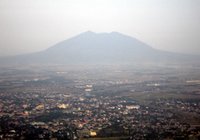 As I mentioned in my earlier entry, it's fun seeing the things down below from a bird's eye view. From the DMIA, you see a different landscape. The most prominent of these attractions is Mount Arayat which towers over the central plains of Luzon. I was able to recognize the City of San Fernando as well. From there, you also see the towns at the Pampanga River delta and Manila Bay.
As I mentioned in my earlier entry, it's fun seeing the things down below from a bird's eye view. From the DMIA, you see a different landscape. The most prominent of these attractions is Mount Arayat which towers over the central plains of Luzon. I was able to recognize the City of San Fernando as well. From there, you also see the towns at the Pampanga River delta and Manila Bay.
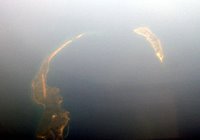 Then Corregidor came into view, like a little tadpole swimming at the mouth of the historic bay. Since we've touched on the island, might as well talk about it. A few years back, I got to take an alternative route to Corregidor, faster at that. We're all familiar with those fastcrafts which leave from the CCP Complex. They charge quite a hefty amount if I remember it right. But if you are vacationing in the Subic or Morong area, you might want to consider visiting the island since it is only 30 minutes by pump boat from a certain barangay in Mariveles.
Then Corregidor came into view, like a little tadpole swimming at the mouth of the historic bay. Since we've touched on the island, might as well talk about it. A few years back, I got to take an alternative route to Corregidor, faster at that. We're all familiar with those fastcrafts which leave from the CCP Complex. They charge quite a hefty amount if I remember it right. But if you are vacationing in the Subic or Morong area, you might want to consider visiting the island since it is only 30 minutes by pump boat from a certain barangay in Mariveles.
 At that time, I think the boat ride costed us PHP1500 total. Imagine the savings if there were more of us. I and a brod, Felix Lopez dared another brod Ryan Tan that we could meet up with him and his family in Corregidor. He thought we were joking since we were in Bataan, hours away from the port in Manila. Hehe! So to make the long story short, we were able to reach the island just as they were about to depart. The good thing about pump boats is that you had your own departure time.
At that time, I think the boat ride costed us PHP1500 total. Imagine the savings if there were more of us. I and a brod, Felix Lopez dared another brod Ryan Tan that we could meet up with him and his family in Corregidor. He thought we were joking since we were in Bataan, hours away from the port in Manila. Hehe! So to make the long story short, we were able to reach the island just as they were about to depart. The good thing about pump boats is that you had your own departure time.
 So after Ryan left, we had our own tour of the island. I contacted Col. Art Matibag, head of the Corregidor Foundation, who was kind enough to lend us a vehicle around the island. I had met Col. Matibag when we were actively pushing for the preservation of the San Fernando Train Station which is a very important Second World War site.
So after Ryan left, we had our own tour of the island. I contacted Col. Art Matibag, head of the Corregidor Foundation, who was kind enough to lend us a vehicle around the island. I had met Col. Matibag when we were actively pushing for the preservation of the San Fernando Train Station which is a very important Second World War site.
Corregidor is actually part of Cavite City although it is closer to Bataan. The other island you see at the tip is Caballo Island. Known as "the rock," it was host to Fort Mills during the American colonial period which is when most of the artilery was placed there. Today it is one of the most important Second World War shrines in the country having been the site of one of the bloodiest battles of the war, the Battle of Corregidor.

 Some of the more popular sites on the island are the batteries, the Corregidor War Memorial, the Corregidor Lighhouse which is one of the few remaining Spanish structures left standing, and Lorca Dock where MacArthur uttered his famous lines, "I shall return!"
Some of the more popular sites on the island are the batteries, the Corregidor War Memorial, the Corregidor Lighhouse which is one of the few remaining Spanish structures left standing, and Lorca Dock where MacArthur uttered his famous lines, "I shall return!"
Anyway, we flew down the coast of Cavite and Zambales, then over the island of Mindoro. Sigh! And we all wonder why we have all these landslides. The forests were all gone. Just a few patches of green. I hope the DENR focuses on protection of what's left as well as reforestation.
From there, we made a right turn toward continental Asia. Didn't see much since it was dark. We arrived in Kuala Lumpur at about 8:30 p.m. after a four hour flight.
I will be flying in a while to KL from the Diosdado Macapagal International Airport in Clark. This is my transition post of sorts. Hehe! From backpacking in the country, it's time to visit our Southeast Asian neighbors and see what they are doing right. The plan is, from KL, I will take a bus to Singapore and back, after which I will take an AirAsia flight to Phnom Penh in Cambodia. From there, I travel by bus to Siem Reap to visit the temples of Angkor.
From Siem Reap, it's another bus to Bangkok in Thailand from where I will take another bus to Vientiane in Laos. A few hours north is the UNESCO World Heritage town of Luang Prabang. Then its back to Bangkok where I take an AirAsia flight back to KL and back to Clark. Let's see how things go.
I purchased the Lonely Planet book Southeast Asia on a Shoestring, and from the data I read, we can see why the Philippines is doing badly with regard to visitor arrivals. To Secretary Durano and our policy makers in the DOT, the advertising is good but unless we sit down with the tourism industry players and work out ways to lower costs of traveling here in the country, the funds spent for advertising would be a waste. At the same time, target backpackers. They are the reason behind the bustling tourism industry in Southeast Asia.
Please see the data below of the average daily budget spent traveling in Southeast Asian countries. I'm not surprised that Brunei Darussalam is at the top, and so is Singapore since the cost of living there is quite high. I'm also not surprised that East Timor is on top since they do not have the necessary tourism infrastructure to bring costs down since they are just a new nation. But the Philippines having the same cost as Singapore?! Hmmm, now Mr. Secretary, that is something we have to consider.
Budget per day (US$)
Brunei Darussalam: 30 to 50
East Timor: 25 to 25
Philippines: 25
Singapore: 25
Vietnam: 23
Indonesia: 15 to 30
Cambodia: 15
Myanmar: 12 to 20
Malaysia: 12
Thailand: 11 to 15
Laos: 10
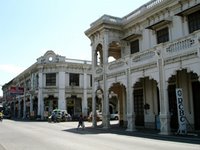 Silay City, this genteel and elegant town north of Bacolod was once an important commercial hub thanks to the introduction of the horno economico (sugar mill) by Yves Gaston, a Frenchman turned Silaynon. What Bacolor was to Pampanga (Athens of Pampanga), Silay was to Negros (Paris of Negros) since it was the cultural and intellectual hub of the province.
Silay City, this genteel and elegant town north of Bacolod was once an important commercial hub thanks to the introduction of the horno economico (sugar mill) by Yves Gaston, a Frenchman turned Silaynon. What Bacolor was to Pampanga (Athens of Pampanga), Silay was to Negros (Paris of Negros) since it was the cultural and intellectual hub of the province.
 I began my day by taking a walk to the Provincial Capitol of Negros Occidental which was just a few minutes from our house. This magnificent structure was designed by none other than renowned architect Juan Arellano and was declared a national historical landmark in 2004. Indeed, it is one of the most monumental provincial capitols ever constructed in our country. Sigh! Reminds me again of the current state of Philippine architecture. Our government engineers don't know the meaning of aesthetics and build structures that simply have four walls and a ceiling! The less materials you use, the more goes into the pockets... Oh well!
I began my day by taking a walk to the Provincial Capitol of Negros Occidental which was just a few minutes from our house. This magnificent structure was designed by none other than renowned architect Juan Arellano and was declared a national historical landmark in 2004. Indeed, it is one of the most monumental provincial capitols ever constructed in our country. Sigh! Reminds me again of the current state of Philippine architecture. Our government engineers don't know the meaning of aesthetics and build structures that simply have four walls and a ceiling! The less materials you use, the more goes into the pockets... Oh well!
 From the capitol, I took a jeep that would drop me off further down the road where jeeps and buses to Talisay, Silay and other northern towns and cities are located. The trip was about thirty minutes and costed me only PHP10. Now that gas is so expensive, prices like these make you want to commute even more. The only thing I didn't like about it was the heat and the drivers stopping too long to attract passengers. In fact, it became so annoying when they'd even back-up to try to lure passengers!
From the capitol, I took a jeep that would drop me off further down the road where jeeps and buses to Talisay, Silay and other northern towns and cities are located. The trip was about thirty minutes and costed me only PHP10. Now that gas is so expensive, prices like these make you want to commute even more. The only thing I didn't like about it was the heat and the drivers stopping too long to attract passengers. In fact, it became so annoying when they'd even back-up to try to lure passengers!
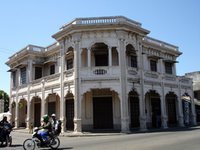 As soon as you exited the city limits of Bacolod, you saw vast fields of sugar cane on either side of the road in Talisay City and then Silay. Sugar really made Negros a very prosperous island which explains why there are so many cities in both provinces, one highly-urbanized city and 12 component cities in Negros Occidental and 5 component cities in Negros Oriental.
As soon as you exited the city limits of Bacolod, you saw vast fields of sugar cane on either side of the road in Talisay City and then Silay. Sugar really made Negros a very prosperous island which explains why there are so many cities in both provinces, one highly-urbanized city and 12 component cities in Negros Occidental and 5 component cities in Negros Oriental.
I knew we were in Silay when the surroundings changed. If not for the jeepneys and other vehicles, you would think you are in another country.
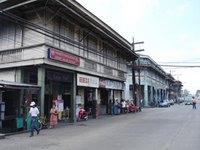 I took a walk around the town and checked out the different houses. At the center of town was the San Diego Pro-Cathedral and its clock tower. Along the main street were old homes and shophouses. Wow! They don't make buildings and houses like this anymore. The designs were so intricate and grand!
I took a walk around the town and checked out the different houses. At the center of town was the San Diego Pro-Cathedral and its clock tower. Along the main street were old homes and shophouses. Wow! They don't make buildings and houses like this anymore. The designs were so intricate and grand!
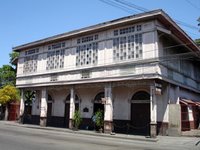 Actually, the City of Silay has the most number of NHI-declared heritage houses, twenty-four if I'm not mistaken. A distant second to Silay is San Fernando, Pampanga with four. The numbers are not conclusive though. It simply shows which cities are most interested in heritage since San Fernando, I would have to admit, will not stand a chance if compared to towns like Sariaya in Quezon, San Juan in Batangas and San Miguel de Mayumu in Bulacan. At the same time, the numbers show how slow it takes the NHI to declare structures! With the speed these structures are demolished, the NHI must match that speed if it is to protect what remains of our national heritage after most of it was flattened during the liberation.
Actually, the City of Silay has the most number of NHI-declared heritage houses, twenty-four if I'm not mistaken. A distant second to Silay is San Fernando, Pampanga with four. The numbers are not conclusive though. It simply shows which cities are most interested in heritage since San Fernando, I would have to admit, will not stand a chance if compared to towns like Sariaya in Quezon, San Juan in Batangas and San Miguel de Mayumu in Bulacan. At the same time, the numbers show how slow it takes the NHI to declare structures! With the speed these structures are demolished, the NHI must match that speed if it is to protect what remains of our national heritage after most of it was flattened during the liberation.
 A visit to Silay would not be complete without passing by Balay Negrense, the Gaston Ancestral House which has been converted into a museum. There is another house open to the public, the Jalandoni Ancestral House, but I didn't have much time since I had to go back to Bacolod to prepare for my late afternoon flight.
A visit to Silay would not be complete without passing by Balay Negrense, the Gaston Ancestral House which has been converted into a museum. There is another house open to the public, the Jalandoni Ancestral House, but I didn't have much time since I had to go back to Bacolod to prepare for my late afternoon flight.
Back in Bacolod, I finished some concerns with the house and I was off. On the way to the airport, I passed by the Bacolod Memorial Park to visit the graves of my grandparents for the very first time. Sigh!
The PAL flight was one-hour delayed. Just great, I shouldn't have rushed. Hehe! And now, I'm back in Manila. I've done a lot of travelling in the Visayas, it's time for a break. I got free AirAsia tickets to Cambodia during their anniversary promo last December (of course we still pay for taxes and insurance so it amounted to about PHP4500). So for next two weeks I'll be blogging about my backpack trip to Cambodia and Laos. But Mindanao here I come coz I was able to purchse the PHP1 tickets of Cebu Pacific. I'm off to Zamboanga and Davao later this year!
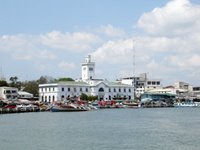 Welcoming us in Iloilo were a few colonial warehouses and the pre-war customs building. I decided to walk around the area to check out the buildings. Wow! Iloilo still had a lot of remnants of its past scattered all over the place. It would be nice to work on an urban renewal plan for Iloilo highlighting all this built heritage. I hope the HCS gets to work on it with Mayor Trenas ASAP since I feel we could replicate the Macau urban renewal success story in Iloilo!
Welcoming us in Iloilo were a few colonial warehouses and the pre-war customs building. I decided to walk around the area to check out the buildings. Wow! Iloilo still had a lot of remnants of its past scattered all over the place. It would be nice to work on an urban renewal plan for Iloilo highlighting all this built heritage. I hope the HCS gets to work on it with Mayor Trenas ASAP since I feel we could replicate the Macau urban renewal success story in Iloilo!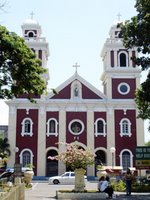 A few meters away from the port was the San Jose Church in downtown Iloilo City. The city is actually composed of several districts which include Jaro, Molo (which was the Chinatown or Parian), Villa de Arevalo (a former capital of Iloilo province which today is called as Villa for short), La Paz (most known for its batchoy), and Mandurriao.After brunch, I took a jeep to Villa and got off near the UP Visayas campus where jeeps to Miag-ao were waiting. My next destination was a UNESCO World Heritage Site, the Church of Sto. Tomas de Villanueva.
A few meters away from the port was the San Jose Church in downtown Iloilo City. The city is actually composed of several districts which include Jaro, Molo (which was the Chinatown or Parian), Villa de Arevalo (a former capital of Iloilo province which today is called as Villa for short), La Paz (most known for its batchoy), and Mandurriao.After brunch, I took a jeep to Villa and got off near the UP Visayas campus where jeeps to Miag-ao were waiting. My next destination was a UNESCO World Heritage Site, the Church of Sto. Tomas de Villanueva.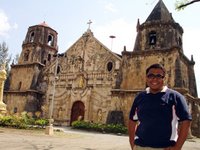 The trip took me about one hour passing through the towns of Oton (the old church of Oton was the pinnacle of religious architecture in the Philippines but was toppled by a strong earthquake in 1948), Tigbauan and Guimbal. Finally, I arrived in Miag-ao! The facade of the church was a work of art and every inch a testament to the craftsmanship of our Filipino ancestors.
The trip took me about one hour passing through the towns of Oton (the old church of Oton was the pinnacle of religious architecture in the Philippines but was toppled by a strong earthquake in 1948), Tigbauan and Guimbal. Finally, I arrived in Miag-ao! The facade of the church was a work of art and every inch a testament to the craftsmanship of our Filipino ancestors.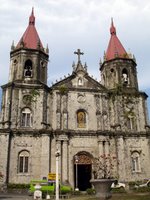 So it was back to Iloilo City to try to visit Molo, Jaro and La Paz. The church of the town after Miag-ao, San Joaquin, was another national cultural treasure. But I didn't have the luxury of time today.
So it was back to Iloilo City to try to visit Molo, Jaro and La Paz. The church of the town after Miag-ao, San Joaquin, was another national cultural treasure. But I didn't have the luxury of time today.
At least Molo was along the way to downtown. So I got off at Molo to check out some churches and houses. I would say that Molo Church is a symbol of feminism because it is a shrine to female saints. The Church of Sta. Ana has on nine statues of female saints on either side of the church, one on every column. At the center retablo is Sta. Ana, mother of Mary. The houses left standing around the area were stunning as well.With Molo done, it was off to Jaro. But traffic was moving really slow. And by 4 p.m., I was still in the public market so I decided not to push through since I could be left behind by the last ferry which left at 5:30 p.m. So I checked mail to kill time. Watching the sun set behind the customs building was just enchanting. On the way back, I took photos of Guimaras Island. Seeing the island, green and untouched, made me realize that the country still had hope if we took care of what was left of it.
Watching the sun set behind the customs building was just enchanting. On the way back, I took photos of Guimaras Island. Seeing the island, green and untouched, made me realize that the country still had hope if we took care of what was left of it.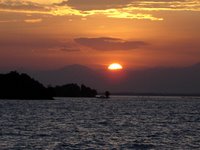 I got back in Bacolod at about 6:30 p.m. Near the cathedral was an area called manukan country, which was a cluster of restaurants ans stalls which served Bacolod's famous chicken inasal. And when in Bacolod, you must try the chicken!I leave for Manila tomorrow. But I have only last stop before going home, the Paris of Negros.
I got back in Bacolod at about 6:30 p.m. Near the cathedral was an area called manukan country, which was a cluster of restaurants ans stalls which served Bacolod's famous chicken inasal. And when in Bacolod, you must try the chicken!I leave for Manila tomorrow. But I have only last stop before going home, the Paris of Negros.
Check out this Inquirer article which came out today for my two seconds of fame! Hehe!
Ang indi makahibalo magbalikid sa iya nga ginhalinan, indi makalab-ot sa iya padulungan. Some refer to it as the national proverb and yet few Filipinos ever put it to heart. That's the Hiligaynon translation. The moment I got off the tricycle in front of our house in Bacolod, I knew I was home.It was refreshing seeing a familiar place although I've been there only thrice in my life and not in the past ten years. As I opened the gate, I felt a surge of energy. Walking around brought back memories more so as I looked at a photo of myself as a kid on the walls of one of the rooms. My grandparents died a few months apart in September 2002 and February 2003. I never got to attend their wakes since for some reason, I was out of the country when it happened. It's a coincidence that they died a few months apart since they were born just two months apart as well.Tired from the non-stop travel, I went straight to bed.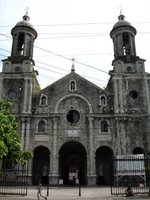 I woke up the next day to catch the ferry to Iloilo City. I had wanted to see Iloilo for the longest time and now that I was in Bacolod, this was my chance. But before that, I walked to the Cathedral of Bacolod which was on the same street as our house, to take photos.Bacolod is called the City of Smiles. Just like the City of San Fernando in Pampanga, Bacolod City is the capital of a rich sugar-producing province, Negros Occidental. It's also a coincidence that both my mom and my dad are from sugar-producing provinces.
I woke up the next day to catch the ferry to Iloilo City. I had wanted to see Iloilo for the longest time and now that I was in Bacolod, this was my chance. But before that, I walked to the Cathedral of Bacolod which was on the same street as our house, to take photos.Bacolod is called the City of Smiles. Just like the City of San Fernando in Pampanga, Bacolod City is the capital of a rich sugar-producing province, Negros Occidental. It's also a coincidence that both my mom and my dad are from sugar-producing provinces. According to oral tradition, the Henares clan were weavers from Iloilo. During the middle of the 19th Century, there was an exodus of migrants from Iloilo to the sparsely-populated island of Negros due to a boom in sugar production. Having been orphaned, the siblings led by Mateo, my great-great grandfather, and his brother Esteban, joined the migration to Negros and upon arriving, armed only with the knowledge of the Spanish language, secured a loan that would serve as capital for what would become a plantation in Talisay.
According to oral tradition, the Henares clan were weavers from Iloilo. During the middle of the 19th Century, there was an exodus of migrants from Iloilo to the sparsely-populated island of Negros due to a boom in sugar production. Having been orphaned, the siblings led by Mateo, my great-great grandfather, and his brother Esteban, joined the migration to Negros and upon arriving, armed only with the knowledge of the Spanish language, secured a loan that would serve as capital for what would become a plantation in Talisay. To make the long story short, the venture boomed. Mateo managed the plantation in Talisay while Esteban took care of business in Bacolod. The brothers were able to build their homes in an area along what is now Rizal Street. This area during the early post-war years was fondly referred to as Henares block since everyone in the block was a Henares. As a result of this hardwork, they were able to send their children to the best schools in Manila, among whom were my great-grandfather Pedro G. Henares (UP College of Medicine, 1915; Bacolod's first health officer, 1917 to 1919; and municipal councilor, 1925 to 1928), and his younger brother Hilarion G. Henares, Sr. (UP College of Engineering, 1917; and a government pensionado), the father of journalist and former cabinet secretary Larry Henares. Esteban Henares even became municipal president (mayor) of Bacolod from 1913 to 1916. Well, that's a little bit of family history and I'll stop here lest I bore you. Hehe!From the cathedral, I took a pedicab to the pier since it was in the reclamation area, quite far for a walk and since no jeeps passed that area. There were a lot of fast ferries available and I picked the one that would bring me there the fastest. Hehe! The student fare on Ocean Jet is PHP221 one-way. Hmmm, I didn't expect it to cost that much for such a short trip. Well, you get what you pay for. The seats were in good condition and they get you there in exactly an hour.
To make the long story short, the venture boomed. Mateo managed the plantation in Talisay while Esteban took care of business in Bacolod. The brothers were able to build their homes in an area along what is now Rizal Street. This area during the early post-war years was fondly referred to as Henares block since everyone in the block was a Henares. As a result of this hardwork, they were able to send their children to the best schools in Manila, among whom were my great-grandfather Pedro G. Henares (UP College of Medicine, 1915; Bacolod's first health officer, 1917 to 1919; and municipal councilor, 1925 to 1928), and his younger brother Hilarion G. Henares, Sr. (UP College of Engineering, 1917; and a government pensionado), the father of journalist and former cabinet secretary Larry Henares. Esteban Henares even became municipal president (mayor) of Bacolod from 1913 to 1916. Well, that's a little bit of family history and I'll stop here lest I bore you. Hehe!From the cathedral, I took a pedicab to the pier since it was in the reclamation area, quite far for a walk and since no jeeps passed that area. There were a lot of fast ferries available and I picked the one that would bring me there the fastest. Hehe! The student fare on Ocean Jet is PHP221 one-way. Hmmm, I didn't expect it to cost that much for such a short trip. Well, you get what you pay for. The seats were in good condition and they get you there in exactly an hour.
 As I mentioned in my earlier entry, it's fun seeing the things down below from a bird's eye view. From the DMIA, you see a different landscape. The most prominent of these attractions is Mount Arayat which towers over the central plains of Luzon. I was able to recognize the City of San Fernando as well. From there, you also see the towns at the Pampanga River delta and Manila Bay.
As I mentioned in my earlier entry, it's fun seeing the things down below from a bird's eye view. From the DMIA, you see a different landscape. The most prominent of these attractions is Mount Arayat which towers over the central plains of Luzon. I was able to recognize the City of San Fernando as well. From there, you also see the towns at the Pampanga River delta and Manila Bay. Then Corregidor came into view, like a little tadpole swimming at the mouth of the historic bay. Since we've touched on the island, might as well talk about it. A few years back, I got to take an alternative route to Corregidor, faster at that. We're all familiar with those fastcrafts which leave from the CCP Complex. They charge quite a hefty amount if I remember it right. But if you are vacationing in the Subic or Morong area, you might want to consider visiting the island since it is only 30 minutes by pump boat from a certain barangay in Mariveles.
Then Corregidor came into view, like a little tadpole swimming at the mouth of the historic bay. Since we've touched on the island, might as well talk about it. A few years back, I got to take an alternative route to Corregidor, faster at that. We're all familiar with those fastcrafts which leave from the CCP Complex. They charge quite a hefty amount if I remember it right. But if you are vacationing in the Subic or Morong area, you might want to consider visiting the island since it is only 30 minutes by pump boat from a certain barangay in Mariveles. At that time, I think the boat ride costed us PHP1500 total. Imagine the savings if there were more of us. I and a brod, Felix Lopez dared another brod Ryan Tan that we could meet up with him and his family in Corregidor. He thought we were joking since we were in Bataan, hours away from the port in Manila. Hehe! So to make the long story short, we were able to reach the island just as they were about to depart. The good thing about pump boats is that you had your own departure time.
At that time, I think the boat ride costed us PHP1500 total. Imagine the savings if there were more of us. I and a brod, Felix Lopez dared another brod Ryan Tan that we could meet up with him and his family in Corregidor. He thought we were joking since we were in Bataan, hours away from the port in Manila. Hehe! So to make the long story short, we were able to reach the island just as they were about to depart. The good thing about pump boats is that you had your own departure time. So after Ryan left, we had our own tour of the island. I contacted Col. Art Matibag, head of the Corregidor Foundation, who was kind enough to lend us a vehicle around the island. I had met Col. Matibag when we were actively pushing for the preservation of the San Fernando Train Station which is a very important Second World War site.
So after Ryan left, we had our own tour of the island. I contacted Col. Art Matibag, head of the Corregidor Foundation, who was kind enough to lend us a vehicle around the island. I had met Col. Matibag when we were actively pushing for the preservation of the San Fernando Train Station which is a very important Second World War site.
 Some of the more popular sites on the island are the batteries, the Corregidor War Memorial, the Corregidor Lighhouse which is one of the few remaining Spanish structures left standing, and Lorca Dock where MacArthur uttered his famous lines, "I shall return!"
Some of the more popular sites on the island are the batteries, the Corregidor War Memorial, the Corregidor Lighhouse which is one of the few remaining Spanish structures left standing, and Lorca Dock where MacArthur uttered his famous lines, "I shall return!"















